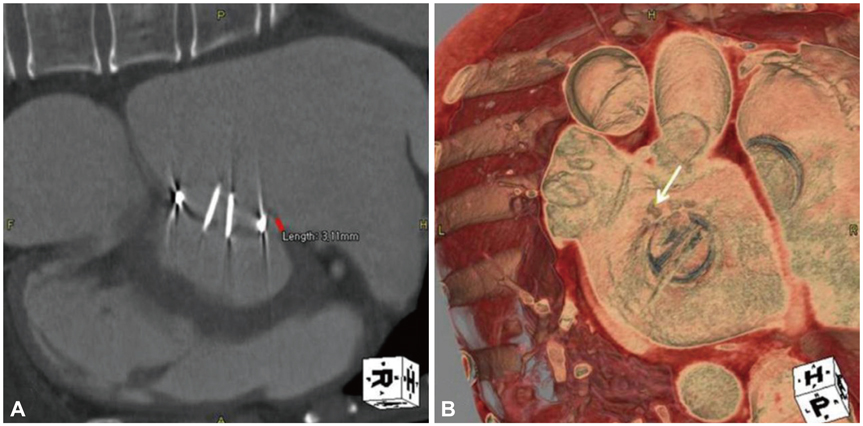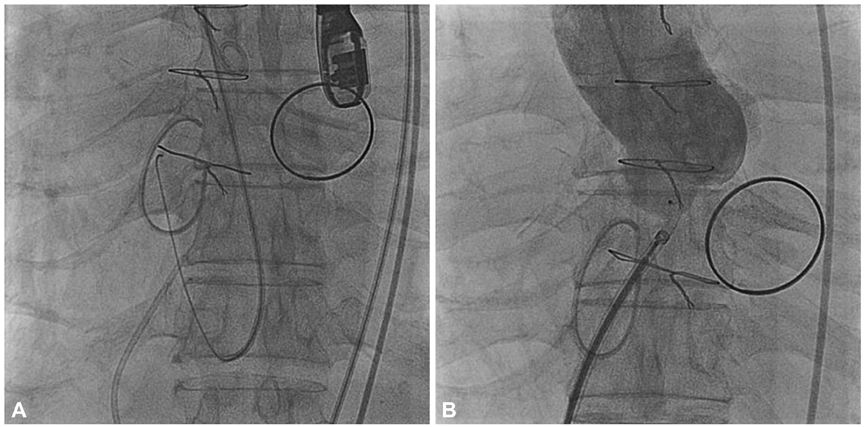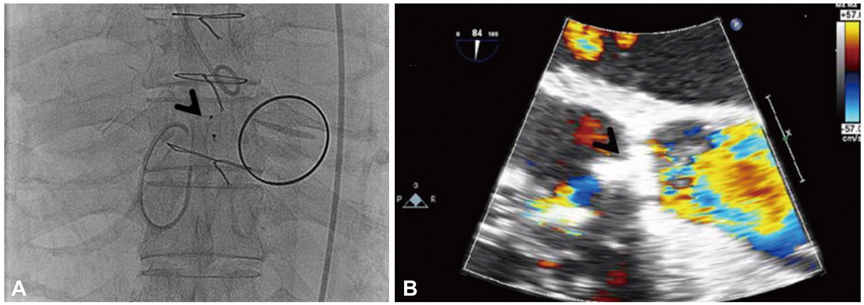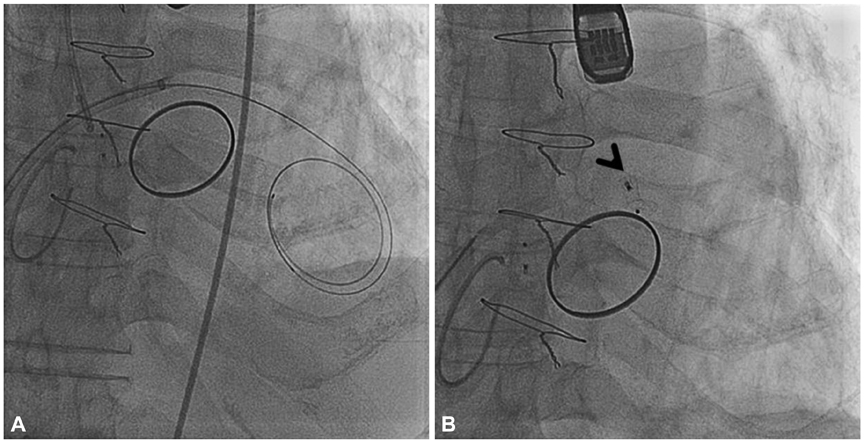Korean Circ J.
2014 Jan;44(1):49-53. 10.4070/kcj.2014.44.1.49.
Transcatheter Closures for Fistula Tract and Paravalvular Leak after Mitral Valve Replacement and Tricuspid Annuloplasty
- Affiliations
-
- 1Department of Internal Medicine, Asan Medical Center, University of Ulsan College of Medicine, Seoul, Korea.
- 2Division of Cardiology, Asan Medical Center, University of Ulsan College of Medicine, Seoul, Korea. jksong@amc.seoul.kr
- 3Division of Cardiology, Daejeon St. Mary's Hospital, The Catholic University of Korea College of Medicine, Seoul, Korea.
- KMID: 1859243
- DOI: http://doi.org/10.4070/kcj.2014.44.1.49
Abstract
- Paravalvular leaks (PVLs) often occur after surgical valve replacement. Surgical reoperation has been the gold standard of therapy for PVLs, but it carries a higher operative risk and an increased incidence of re-leaks compared to the initial surgery. In high surgical risk patients with appropriate geometries, transcatheter closure of PVLs could be an alternative to redo-surgery. Here, we report a case of successful staged transcatheter closures of a fistula tract between the aorta and right atrium, and mitral PVLs after mitral valve replacement and tricuspid annuloplasty.
Figure
Reference
-
1. Kursaklioglu H, Barcin C, Iyisoy A, Baysan O, Celik T, Kose S. Percutaneous closure of mitral paravalvular leak via retrograde approach: with use of the Amplatzer duct occluder II and without a wire loop. Tex Heart Inst J. 2010; 37:461–464.2. Kuehl M, Schreieck J, Burgstahler C. Percutaneous closure of a periprosthetic leakage after mitral valve reoperation due to recurrent endocarditis. Catheter Cardiovasc Interv. 2009; 73:838–841.3. Pate GE, Al Zubaidi A, Chandavimol M, Thompson CR, Munt BI, Webb JG. Percutaneous closure of prosthetic paravalvular leaks: case series and review. Catheter Cardiovasc Interv. 2006; 68:528–533.4. Hourihan M, Perry SB, Mandell VS, et al. Transcatheter umbrella closure of valvular and paravalvular leaks. J Am Coll Cardiol. 1992; 20:1371–1377.5. Eisenhauer AC, Piemonte TC, Watson PS. Closure of prosthetic paravalvular mitral regurgitation with the Gianturco-Grifka vascular occlusion device. Catheter Cardiovasc Interv. 2001; 54:234–238.6. Webb JG, Pate GE, Munt BI. Percutaneous closure of an aortic prosthetic paravalvular leak with an Amplatzer duct occluder. Catheter Cardiovasc Interv. 2005; 65:69–72.7. Binder RK, Webb JG. Percutaneous mitral and aortic paravalvular leak repair: indications, current application, and future directions. Curr Cardiol Rep. 2013; 15:342.8. Nietlispach F, Johnson M, Moss RR, et al. Transcatheter closure of paravalvular defects using a purpose-specific occluder. JACC Cardiovasc Interv. 2010; 3:759–765.9. Pate GE, Thompson CR, Munt BI, Webb JG. Techniques for percutaneous closure of prosthetic paravalvular leaks. Catheter Cardiovasc Interv. 2006; 67:158–166.10. Cortés M, García E, García-Fernandez MA, Gomez JJ, Perez-David E, Fernández-Avilés F. Usefulness of transesophageal echocardiography in percutaneous transcatheter repairs of paravalvular mitral regurgitation. Am J Cardiol. 2008; 101:382–386.11. Kort HW, Sharkey AM, Balzer DT. Novel use of the Amplatzer duct occluder to close perivalvar leak involving a prosthetic mitral valve. Catheter Cardiovasc Interv. 2004; 61:548–551.12. Shapira Y, Hirsch R, Kornowski R, et al. Percutaneous closure of perivalvular leaks with Amplatzer occluders: feasibility, safety, and shortterm results. J Heart Valve Dis. 2007; 16:305–313.
- Full Text Links
- Actions
-
Cited
- CITED
-
- Close
- Share
- Similar articles
-
- Trido Mitral Valve Replacement with Dacron Collar Prosthetic Valve due to Paravalvular Leak
- ITBI Repair of Paravalvular Leak at Mitral Position after Redo DVR
- Left Atrial Wall Dissection after Mitral Valve Replacement
- Hemodynamic Improvement after Surgical Intervention for Pannus in Prosthetic Mitral Valve
- Comparable Outcomes of Bicuspid Aortic Valves for RapidDeployment Aortic Valve Replacement








